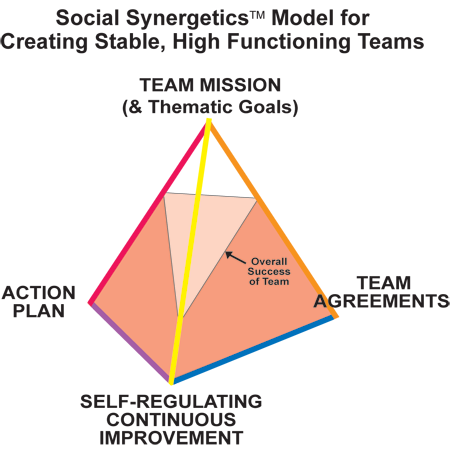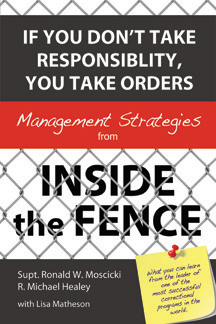High Functioning Teams


This article provides a “how-to” for developing a high functioning team. The overall strategy is detailed, along with a discussion of tactics, starting with a definition of high functioning team, and a question that needs to be addressed: “Why put the effort into developing a team – why not just maintain the status quo”?
Definition of a High Functioning Team
For the purposes of this discussion, a high functioning team is one that performs above average in objective metrics, as well as in areas that are subjective and not as easily quantified or measured. The term “above average” is in comparison to teams in the same organization and/or industry that are in the same functional arena.Objective metrics are the areas that are typically measured for the subject functional areas, it could include one or more of the following: quality, speed of service, profitability, revenue generation, customer satisfaction scores, or something beyond these examples that is specific to an organization or industry.
Subjective areas include: team members’ sense of belonging, sense of job satisfaction, sense or purpose for the job, self-motivation, the camaraderie amongst team members, and the culture or environment.
There are many possible indicators of success. On high functioning teams, the majority of members experience a feeling of contentment, juxtaposed by a “creative tension” that is the byproduct of continuously striving to work better as a team to ever better results. The team also creates an environment of personal responsibility where all members are accountable to each other and the team as a whole.
High functioning teams can be developed in any sector – public, private, non-profit, social service agencies, unionized and volunteer.
Behaviors of a High Functioning Team
Most high functioning teams:- Are self-correcting/self-regulating – have a code of conduct that allows the team to confront any situation that arises in a productive, effective and efficient manner.
- Are self-directed – setting and achieving goals that are ever more challenging.
- Have protocols in place designed to regularly challenge and assess legacy processes for effectiveness. Continuously work towards process improvement and innovation.
- Have a culture of on-going personal/professional growth and development.
- Understand conflict is a necessary aspect of healthy teams and manage conflict.
How A Team Becomes High Functioning
Most of the high functioning teams that have been studied were not created by happenstance. Rather, the team engaged in strategic, targeted processes over a period of time, which led to the above average results.The strategies outlined here are a coalescence of processes and models proposed and developed by other authors, most notably Patrick Lencioni in his book, The 5 Dysfunctions of a Team, and was also generally inspired by the works of Stephen Covey and Peter Senge.
Lencioni identifies 5 areas of functionality on teams, that, when not working well, lead to dysfunction and when working well, lead the team to high levels of functionality. While each of the functions are important in their own right, and can be developed independently, some create a foundation on which the other functions can be built, and therefore, must be in place, to a degree, before the higher-level functions can be significantly developed.
Visually they form a two-dimensional pyramid with TRUST at the bottom, then the ability to master CONFLICT, followed by COMMITMENT, then ACCOUNTABILITY, and finally FOCUS ON RESULTS.
Developing a Foundation of Trust
Clearly a team that does not have trust amongst the team members can’t have commitment and will never achieve accountability or results (consistently above average). A team that can’t handle conflict can’t develop commitment, and so on.The process for developing a high functioning team starts with the building of trust within the team. There are many processes that can be deployed to bring about increased trust. Some teams that have worked successfully together over a period of time may have developed a requisite level of trust. However, time spent together does not guarantee trust. In fact, most teams, despite time together, do not have the level of trust necessary as a foundation for becoming a high functioning team.
One of the best processes for developing trust is for the team members to get to know and understand one another at a deeper level. A good launching pad for better understanding of each other is some form of personality and/or behavior profiling.
The purpose personality or behavior profiling is not to pigeon-hole or stigmatize any team members. The primary purpose is to Identify different behavior and communication style preferences. Team members can then Adapt their own style when interacting with others, and in doing so, Connect with them. This creates a good beginning foundation for trust.
It is amazing how often conflict situations are unproductive primarily due to style differences amongst the “combatants”.
In addition to, and in concert with, the above, the following model is a step-by-step process for building a high-functioning team.
STEP 1: Team Mission
The first step is to develop a team mission statement. A team mission statement is not the same as an organizational mission statement. The team mission statements address one concept only, and that is: “Why are we here?” – the “we” being the team and the individuals on the team.In addition to stating the purpose, team-type mission statements need to be succinct – the most powerful are typically 7 – 10 words or less and speak only to purpose – the real question is “why”. Statements that begin with “We are a team of dedicated ….” are addressing “who”. Keep it lean and targeted on “why”.
There are two sides to the “Why are we here?” question. Why is the team here – what is the output/deliverable of the team? And, equally importantly, why are the individual members here?
Team members must ask and be able to answer for themselves, “Why work in this industry and for this company and on this team?” There are other industries, companies and teams that are possibilities, so the goal of this question is to get to a meaningful answer.
The easy, and somewhat cynical, answer is some version of “It’s a job” or “It’s a paycheck”. This answer full of “attitude” is often the end product of an individual not being inspired by the job for some period of time. To turn this around, it can be useful to assist people in getting in touch with the feelings-motivation-inspiration they had when they first started the job or joined the organization. What were their aspirations then? Frequently, reconnecting to those earlier motivations can inspire a renewed commitment to the role and/or team.
Front line health care is a prime example of the power of re-connecting. Many who deliver front line health report the reason they chose the field was a strong desire to “help people”. And yet, some years later they feel unfulfilled, uninspired and are just “going through the motions”. When they reconnect with, and begin thinking daily, about how they and the team they are on can help people, they become re-inspired, begin thinking more creatively about their role and have a renewed sense of purpose in the jobs.
The final element in using a team mission statement as a foundation for transforming a team is to operationalize the mission statement. Mission statements that are created and posted on the wall or on the intranet but have no operational relevance to the team members are essentially non-functioning statements. The team needs to take action to bring the mission into reality.
In his book, It’s Our Ship, Captain Michael Abrashoff details many of the steps taken on the USS Benfold to transform it from one of the lowest performers in the US Navy to one of the highest. One of the key steps was the development of a mission statement. Captain Abrashoff conducted interviews with all the sailors on board the ship. In part, he discovered that many of the sailors joined the Navy to “get away” from less than positive home situations, and further, they were attracted to the “be all you can be” concept.
Ultimately the mission statement “This is the best damn ship in the Navy” evolved from those interviews and from Captain Abrashoff’s desire for the crew to aspire to something big.
STEP 2: Team Agreements
The next step is to develop a set of “rules” for interaction on the team. Ideally the “rules” would cover areas of interaction between team members. They typically include statements inferring items like respect (for time, ideals, personal style preferences, etc.), how to handle conflict, decision-making processes (consensus, majority, veto’s, etc.), commitment to the team, etc. etc. These rules are variously called Rules of Engagement, Code of Conduct, Team Agreements, depending on the sensibilities of each team.STEP 3: Thematic Goals
Developing a set of Thematic Goals is next – usually 3- 5 are actively pursued at any given time. Thematic goals do not need to be objectively measurable (although they can be) and are not necessarily realistic (ie. zero defects in a manufacturing process, zero incidents in a transportation company, etc.). Thematic goals typically include goals revolving around the output of the team (quality, safety, etc.) and/or the environment of the team (innovation, managing conflict, job satisfaction, cohesion, etc.), principles or values.Some teams develop their own thematic goals based on team discussions and a consensus amongst the team members. Other teams use concepts proposed by other authors. The possibilities are endless; however, here are three examples to stimulate thought:
- In a series of books generally referred to as the Fish Philosophy, the authors detail the success of a retail seafood operation and the 4 principles the operation used to drive their success. In one of the books, Fish Tales, the authors track how those principles were executed in a variety of organizational settings with very good results. These teams used the Fish principles as thematic goals.
- Some teams have adopted Stephen Covey’s 7 Habits of Highly Effective People as their thematic goals.
- Other groups have used the principles and concepts from Spencer Johnson’s Who Moved My Cheese materials.
Whether the thematic goals are internally developed, derived from an external source or some combination thereof, the important elements are that the team is engaged in the pursuit of the goals and the goals are not operational goals, which are often goals that are “pushed” down from above.
Being able to measure and assess progress is important to goal achievement, ensuring the team is heading in the desired direction, and feelings of accomplishment by team members. Objective measurement of thematic goals is frequently not realistic, therefore a subjective measurement system needs to be developed. Sometimes simple is better. A system that is easy to develop and administer uses a 1 – 10 scale. Staff are surveyed regularly and asked to rate the groups or individual’s proficiency over the previous period. This rating can then be compared to the ratings from earlier periods to determine the trend.
Hypothetically, consider a management team that has as one of its thematic goals: Increased job satisfaction of all staff reporting to the team members. A confidential periodic survey (monthly/quarterly) could be completed by all subject staff. The survey would ask each staff person to rate their level of job satisfaction on a scale of 1-10, with 10 being the highest. The management team would then have a regular assessment of their progress on the thematic goal. This is obviously a simplification for demonstration purposes.
STEP 4: Action Plan
Creating and regularly updating an action plan to achieve the regular goals and objectives of the team, as well as, the thematic goals. The Action Plan should also include a regular and systematic review of the plan to assess effectiveness.STEP 5: Commitment to Continuous Improvement
High functioning teams are always striving to be better. They may have the highest metrics compared to other teams in their industry or organization, but they don’t rest on those laurels.The striving for continuous improvement is found in several areas, including:
- Team Functioning – Finding ever better ways of working together and supporting one another, including improving how new team members are incorporated into the functioning of the team.
- Process Improvement – A strategy of continuously searching out ways to improve team and organizational processes. Many teams incorporate a process of regularly challenging legacy processes (the way we have “always” done it) to determine if the legacy is the most productive method to achieve the desired result. Individual
- Growth and Development – Each team member is committed to their own on-going growth and development, professionally and/or personally.
For more information on how to begin the process of creating a HIGH FUNCTIONING TEAM with your team or organization, contact us.


